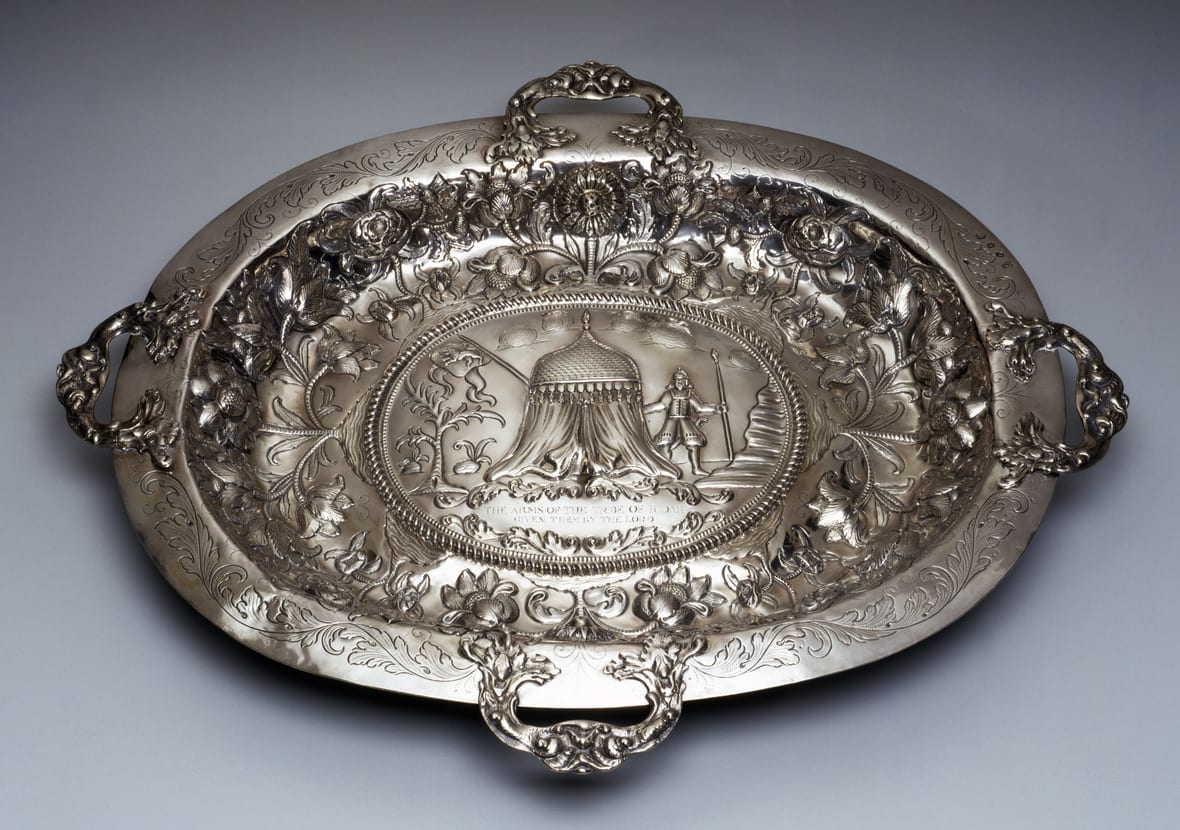
- Object Name:
- Presentation Tray
- Artist/Maker:
- John Ruslen
- Bio:
- active 1656-c. 1715
- Title:
- Lord Mayor's Tray
- Place Made:
- London, England
- Date:
- 1708–09
- Medium:
- Silver: repoussé and engraved
- Dimensions:
- 21 3/8 × 26 1/2 × 3 1/4 in. (54.2 × 67.3 × 8.3 cm)
- Credit Line:
- Gift of Frieda Schiff Warburg
- Accession Number:
- JM 2-47a-b
Not On View
In 1656, Jews were readmitted to the British Isles, after a 350 - year hiatus, through the joint efforts of Oliver Cromwell and the Dutch messianic scholar Menasseh ben Israel. The following year, London's small Spanish and Portuguese community established the Bevis Marks Congregation, still one of that city's major synagogues.
This four-handled tray represents the congregants' 100 - year annual tradition of offering presentation silver to London's lord mayor. Beginning in 1679, silver trays were commissioned for the mayor and sent to him, lavishly filled with sweetmeats. Most of these gifts bear as a central motif the seal of the Bevis Marks Congregation--a Tent of Assembly in the wilderness, a guard at its entrance, the whole surmounted by a cloud of glory. Similar presentation pieces were also offered to the lord mayor by other minority groups, namely, the Dutch Reform and French Protestant churches.
This lord mayor's tray was fashioned by John Ruslen, a well-established English silversmith who had for twenty-eight years provided Jewish ritual objects for Bevis Marks. Aside from his five existing presentation salvers, records indicate commissions for a sanctuary lamp in 1682; a pair of Torah finials (rimmonim) in 1702; and the Hanukkah lamp of 1709, depicting Elijah and the ravens. The Dutch-influenced repoussé work and chasing of Ruslen's tray demonstrate the polarity of silver styles coexisting during Queen Anne's reign. The ornate, if retardataire, style of this tray was considered appropriate for royal commissions and presentation pieces. Its decoration contrasts markedly with the severity of most silver intended for domestic use during this period. This tray shows the continuing demand for opulent silver that followed the restoration of Charles II in 1660. Charles, who had been in exile in the Netherlands and France, returned, bringing with him a taste for Dutch Baroque and the regal style of Louis XIV. These tendencies were quickly adapted by English artisans.
Like the Jews, Huguenots also sought freedom and opportunity in seventeenth-century England. After 1685, Huguenot silversmiths began to arrive in London when the French revoked the Edict of Nantes, which had originally granted religious liberties to Protestants in France. These foreign craftsmen brought new stylistic elements and technical innovation to the repertoire of English silver and, not least, forced unexpected competition upon native silversmiths. The simplicity pervading most Queen Anne silver was due in part to the new regulations requiring higher silver content for plate and the consequent need to reduce the costs of fabrication. Contrary to these exigencies, the sumptuous Ruslen tray aptly demonstrates that the Bevis Marks congregants spared no expense to honor their lord mayor.
This four-handled tray represents the congregants' 100 - year annual tradition of offering presentation silver to London's lord mayor. Beginning in 1679, silver trays were commissioned for the mayor and sent to him, lavishly filled with sweetmeats. Most of these gifts bear as a central motif the seal of the Bevis Marks Congregation--a Tent of Assembly in the wilderness, a guard at its entrance, the whole surmounted by a cloud of glory. Similar presentation pieces were also offered to the lord mayor by other minority groups, namely, the Dutch Reform and French Protestant churches.
This lord mayor's tray was fashioned by John Ruslen, a well-established English silversmith who had for twenty-eight years provided Jewish ritual objects for Bevis Marks. Aside from his five existing presentation salvers, records indicate commissions for a sanctuary lamp in 1682; a pair of Torah finials (rimmonim) in 1702; and the Hanukkah lamp of 1709, depicting Elijah and the ravens. The Dutch-influenced repoussé work and chasing of Ruslen's tray demonstrate the polarity of silver styles coexisting during Queen Anne's reign. The ornate, if retardataire, style of this tray was considered appropriate for royal commissions and presentation pieces. Its decoration contrasts markedly with the severity of most silver intended for domestic use during this period. This tray shows the continuing demand for opulent silver that followed the restoration of Charles II in 1660. Charles, who had been in exile in the Netherlands and France, returned, bringing with him a taste for Dutch Baroque and the regal style of Louis XIV. These tendencies were quickly adapted by English artisans.
Like the Jews, Huguenots also sought freedom and opportunity in seventeenth-century England. After 1685, Huguenot silversmiths began to arrive in London when the French revoked the Edict of Nantes, which had originally granted religious liberties to Protestants in France. These foreign craftsmen brought new stylistic elements and technical innovation to the repertoire of English silver and, not least, forced unexpected competition upon native silversmiths. The simplicity pervading most Queen Anne silver was due in part to the new regulations requiring higher silver content for plate and the consequent need to reduce the costs of fabrication. Contrary to these exigencies, the sumptuous Ruslen tray aptly demonstrates that the Bevis Marks congregants spared no expense to honor their lord mayor.
Information may change as a result of ongoing research.